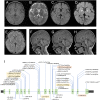Leigh-like syndrome with progressive cerebellar atrophy caused by novel HIBCH variants
- PMID: 37604814
- PMCID: PMC10442384
- DOI: 10.1038/s41439-023-00251-y
Leigh-like syndrome with progressive cerebellar atrophy caused by novel HIBCH variants
Abstract
Pathogenic variants in the HIBCH gene cause HIBCH deficiency, leading to mitochondrial disorders associated with valine metabolism. Patients typically present with symptoms such as developmental regression/delay, encephalopathy, hypotonia and dystonia. Brain magnetic resonance imaging (MRI) shows bilateral lesions in the basal ganglia with/without brainstem involvement. Here, we report a case of a Japanese patient with Leigh-like syndrome caused by novel HIBCH variants. Long-term follow-up MRI revealed progressive cerebellar atrophy, which expands the phenotypic spectrum of HIBCH deficiency.
© 2023. Japan Society of Human Genetics.
Conflict of interest statement
The authors declare no competing interests.
Figures

Similar articles
-
[3-Hydroxy-isobutyryl-CoA hydrolase deficiency in a child with Leigh-like syndrome and literature review].Zhonghua Er Ke Za Zhi. 2015 Aug;53(8):626-30. Zhonghua Er Ke Za Zhi. 2015. PMID: 26717663 Review. Chinese.
-
Delineating the neurological phenotype in children with defects in the ECHS1 or HIBCH gene.J Inherit Metab Dis. 2021 Mar;44(2):401-414. doi: 10.1002/jimd.12288. Epub 2020 Aug 16. J Inherit Metab Dis. 2021. PMID: 32677093
-
MRI of 3-hydroxyisobutyryl-CoA hydrolase (HIBCH) deficiency.Radiol Case Rep. 2021 Jan 27;16(4):807-810. doi: 10.1016/j.radcr.2021.01.021. eCollection 2021 Apr. Radiol Case Rep. 2021. PMID: 33552330 Free PMC article.
-
Cinical, Metabolic, and Genetic Analysis and Follow-Up of Eight Patients With HIBCH Mutations Presenting With Leigh/Leigh-Like Syndrome.Front Pharmacol. 2021 Mar 8;12:605803. doi: 10.3389/fphar.2021.605803. eCollection 2021. Front Pharmacol. 2021. PMID: 33762937 Free PMC article.
-
[Molybdenum cofactor deficiency type B manifested as Leigh-like syndrome: a case report and literature review].Zhonghua Er Ke Za Zhi. 2021 Feb 2;59(2):119-124. doi: 10.3760/cma.j.cn112140-20200911-00866. Zhonghua Er Ke Za Zhi. 2021. PMID: 33548958 Review. Chinese.
Cited by
-
Identification of HIBCH and MGME1 as Mitochondrial Dynamics-Related Biomarkers in Alzheimer's Disease Via Integrated Bioinformatics Analysis.IET Syst Biol. 2025 Jan-Dec;19(1):e70018. doi: 10.1049/syb2.70018. IET Syst Biol. 2025. PMID: 40286336 Free PMC article.
-
A Fatal Case of 3-Hydroxyisobutyryl-CoA Hydrolase Deficiency in a Term Infant with Severe High Anion Gap Acidosis and Review of the Literature.Case Rep Genet. 2024 Jun 30;2024:8099373. doi: 10.1155/2024/8099373. eCollection 2024. Case Rep Genet. 2024. PMID: 38975013 Free PMC article.
References
LinkOut - more resources
Full Text Sources

